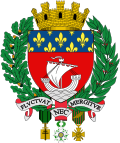
| History of Paris |
|---|
 |
| See also |
|
|
During the Second French Empire, the reign of Emperor Napoleon III (1852–1870), Paris was the largest city in continental Europe and a leading center of finance, commerce, fashion, and the arts. The population of the city grew dramatically, from about one million to two million persons, partly because the city was greatly enlarged, to its present boundaries, through the annexation of eleven surrounding communes and the subsequent creation of eight new arrondissements.
In 1853, Napoleon III and his prefect of the Seine, Georges-Eugène Haussmann, began a massive public works project, constructing new boulevards and parks, theaters, markets and monuments, a project that Napoleon III supported for seventeen years until his downfall in 1870, and which was continued afterward under the Third Republic. The street plan and architectural style of Napoleon III and Haussmann are still largely preserved and manifestly evident in the center of Paris.